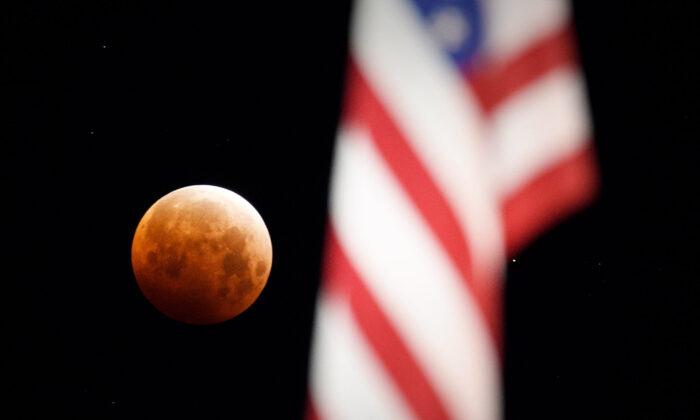For the first time in American history, a total lunar eclipse will occur on election day come November 8, 2022.
A total lunar eclipse—not to be confused with a partial or penumbral lunar eclipse—occurs when the entire lunar sphere is blocked out by the Earth’s shadow. This happens about twice a year on average, but to have it happen on America’s election day is a first in the nation’s 246-year history, which began on July 4, 1776.
Lunar Eclipses and Full Moons
Total lunar eclipses always occur during a full moon, when the sun, Earth, and Moon (in that order) basically form a straight line, and the Moon appears its roundest in the night sky. Occasionally, when a full moon crosses through the Earth’s shadow, partially or entirely, a general phenomenon known as a lunar eclipse appears. There are different kinds of lunar eclipses with varying degrees of totality, some being more noticeable and others less so.The area of the Earth’s shadow where the sun is partially blocked out by our planet, from the standpoint of outer space, is called the penumbra; when the moon crosses this area, the result is what’s called a penumbral eclipse, which may manifest as a slight dimming of the lunar surface when viewed from Earth.
The area of the Earth’s shadow where the sun is fully obliterated from view, from an interstellar perspective, is the umbra; when the Moon enters here, the result is either a total lunar eclipse when it is fully enshrouded, or partial lunar eclipse when it partially crosses that threshold. Total eclipses tend to cause the full moon to turn a rust red, and thus they are sometimes called “blood moons.”

How To Catch the Total Lunar Eclipse
In short, the total eclipse begins at 5:16 a.m. EST and ends at 6:41 a.m., for a total duration of about 85 minutes. Maximum eclipse occurs at 5:59 a.m. EST. Look to the east; the November full moon can be found, like on most years, in front of the constellation Taurus.Although penumbral eclipses typically go unnoticed by the human eye, you should be able to witness this total lunar eclipse unaided in the wee hours of election day, given clear skies and an unobstructed vantage point. If you grab a pair of binoculars, you may catch sight of the planet Uranus about two moon widths above the eclipsed satellite. Speaking of planets, Mars will also make an appearance low, near the horizon, slightly northward of the rust-red moon.
- The Moon’s penumbral eclipse (when the Moon enters the penumbra) begins at 3:02 a.m. EST.
- The partial eclipse (when the Moon partially enters the umbra) begins at 4:09 a.m. EST.
- Totality (when the Moon is fully engulfed by the umbra) begins at 5:16 a.m. EST.
- Maximum eclipse (when the Moon passes through the central axis of the Earth’s shadow) will occur at 5:59 a.m. EST.
- Totality ends at 6:41 a.m. EST.
- Partial eclipse ends at 7:49 a.m. EST.
- Penumbral eclipse ends at 8:56 a.m. EST.
How Rare is a Total Lunar Eclipse on Election Day?
As for the rareness of a total lunar eclipse falling on election day, this won’t happen again for another 372 years—not until Tuesday, November 8, 2394 (that is, if the United States of America carries on the tradition of elections that far). Notably, Tuesday, November 3, 1846, saw a rather shallow penumbral lunar eclipse fall on voting day, though it probably would have gone unnoticed by your typical observer. Likewise, another penumbral lunar eclipse will occur 372 years after that one; that will be on Tuesday, November 3, in the year 2218 (These neat factoids, originally drawn from Fred Espenak’s Six Millennium Catalog of Lunar Eclipses, were obtained from EarthSky.org). In other words, we likely won’t see another total eclipse on election day ever in our lifetime.According to constitutional stipulations, elections must fall on even-numbered years, and must be on “the Tuesday next after the first Monday in the month of November.” That means election days always fall on November 2, 3, 4, 5, 6, 7, or 8. Thus the factors have aligned—both cosmic and constitutional—to manifest a red moon hours before what many predict could be a red wave.







